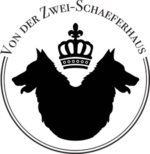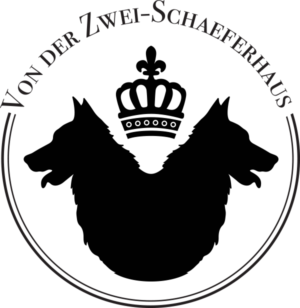Training
“In 1903, recognizing the detrimental effects of breeding for fashion and what Max von Stephanitz (the father of the German Shepherd Dog) called “kennel breeding”, the verein fur Deutsche Schaferhund (SV) drew up a scheme of tests to evaluate the breeding program of it’s imerging yet beloved German Shepherd Dog. These tests or efficiency trials were known as “Der Schaferhund als Diensthund” (The German Shepherd Dog as service dog) and also were used to prove the breed’s value to the police and military. Over time, “Diensthund” (Police Dog) evolved into the broader “Schutzhund” (Protection Dog) – a sport enjoyed worldwide today.”
The Schutzhund trial is a series of complex tests originally designed to make inappropriate breeding less rewarding. Each dog must prove he or she is of sound mind and body – an animal worthy of being bred. A breeder that cannot produce dogs of the caliber necessary to pass should be discouraged from breeding altogether. In addition, the considerable time and effort spent training and conditioning the dog develops a greater understanding of the physical and mental attributes required of the breed, and further promotes good breeding practices.
In his book “The German Shepherd Dog in Word and Picture”, von Stephanitz wrote: ‘the breeding of shepherd dogs is the breeding of working dogs; and this must always be the aim or we shall cease to produce shepherd dogs… The work of breeding service dogs must, first and foremost, be the work of dog lovers… The dog lover in his breeding aspires after no material and external advantage. He allows himself to be contented with the fact that association with noble, beautiful and gifted creatures, the observation of phenomena of their lives and the examination of all that happens in their breedings afford him a whole cycle of pure joys and contentment and allow him to penetrate further into the secrets and the mysteries of nature. These joys will repay him (who indulges his fancy without self-seeking) for all the sacrifices in money, time and trouble and even for all failures and disillusions”.
One of the positive consequences of Schutzhund is that the quantity of one-on-one necessary for training encourages deep bonds, mutual respect and a good relationship between trainer and dog. The sport of Schutzhund gained a firm foothold in this country in the 1970’s and despite an overall anti-dog atmosphere in many communities, the sport continues to grow. Although purebred dogs make up the majority of sport dogs, any breed – even mixed breeds – may compete if they can meet the physical and mental requirements.
Schutzhund trials worldwide generally follow one set of rules set forth by the Verein fur Deutsche Hunde (SV) German Regulatory organization for rules and regulations. Slight adjustments to the rules are made by the VDH and individual countries from time to time as the sport continues to evolve. Each year world championships are held – one all breed championship (The Federation Cynologique International World Championship) and several breed-specific world championships. The German Shepherd Championships is called the WUSV World Championship and is held in a different country each fall.
The Basics
A Schutzhund trial is broken down into three distinct phases, each worth 100 points. (300 points for a perfect score) The first phase is tracking which tests the dog’s scenting ability, trainability and physical and mental endurance. The second is obedience which tests the dog’s overall temperament, structural efficiencies and willingness to work for his handler. The final phase is protection, which tests the dog’s courage, physical strength, stability, obedience and character while in a higher drive. There are three levels of achievement called titles or degrees. The dog must pass his Schutzhund 1 before he is allowed to compete at the next level, Schutzhund 2. Schutzhund 3 is the final level. At the start of the trial, the judge performs a brief temperament evaluation on all participating dogs. Overly aggressive or uncontrollable dogs are dismissed from the trial before ever stepping on to the competition field. The dog must then achieve a minimum score of 70 points in tracking, 70 points in obedience and 80 points in protection under a certified judge during an authorized event in order to pass and proceed to the next level. All three phases are done in succession on the same day and all three must be passed on that day. Due to the length of time needed to evaluate each dog, the trial is limited to 12 dogs per day. At a typical trial, competitors meet for tracking early in the morning and often work until late in the afternoon, making for a gruelling but exciting day!
At least two weeks prior to competition for his Schutzhund title, a dog must pass the “Begleithunde” or Companion Dog test at a Schutzhund trial. The “B” was developed as a preliminary character evaluation test involving a shortened obedience (pass/fail) routine, plus a traffic saftey examination, involving joggers, crowds, bikes, cars, loud noises, gunshots, bells and strange dogs – all designed to weed out overly aggressive or nervous dogs from the gene pool. All dogs must pass the B to prove they have sound temperament before being allowed to compete for a Schutzhund title. All scores (even failing ones) are recorded in a dog’s scorebook, which is presented to the judge at the start of each trial. If a dog does not compete in all phases of the trial, the reason(s) for the dismissal are recorded. A copy of the trial results are filed with the national organization.
Obedience
After all the dogs finish tracking, the obedience portion takes place. The ideal field is about the size of a soccer field.Two dog/handler teams report on the field to the judge. One handler is instructed to place their dog in a long down and move away or out of sight. This dog must remain in the down position without influence from the handler while the other dog/handler team completes all exercises except the last exercise, the send out. He must remain motionless until picked up by his handler. The other team begins the exercises once the first handler is in place. All exercises start from the basic position (dog sitting at heel). The handler is only permitted to use a voice command when starting the exercises or changing pace. Hand signals are not allowed and body language is penalized. The team must be precise and spirited. The dog should perform the exercises quickly, willingly and without handler help. Dogs that are slow to perform the exercise or show stress are penalized. A happy eager dog that works as part of a well synchronized team is the ideal obedience partner. Exercises increase in difficulty with each level and include heeling on and off leash (under gun fire) as well as through a group of people, a sit, down and/or stand out of motion with some of the exercises recalling the dog and others requiring the dog to stay. As well, retrieving on the flat, over a hurdle and scaling wall, and a send away, comprise the exercises in the routines. At the completion of both dog/handler teams obedience exercises, a detailed critique and the score is addressed to the audience by the judge.
Tracking
The tracking portion consists of a track from 400 to 800 paces with up to three articles and four 90 degree turns at the Schutzhund three level. The handler follows the dog on or off leash approximately 10 meters behind. The only visible indication of the track is the starting flag. Articles should not differ in color from the terrain, cannot be larger than the size of a wallet and are often much smaller. One dog/handler team reports to the judge and then begins the track. At the start of the track, the dog must take sufficient time to absorb the scent. Then he must pick up the scent and prodceed with a deep nose. A slow methodical tracking dog is preferred – accuracy, not speed, is required. The dog is judged on his intensity, confidence and obedience on the track. When the dog finds an article, he must immediately indicate that he has done so without being influenced by the handler. The indication can be a ‘down’, a ‘sit’ or a ‘stand’.The dog may also indicate the article by retrieving it. The handler drops the leash and proceeds to his dog, lifting the article high in the air to indicate to the judge that it has been found. The handler then gives the command to continue the track, again following behind the dog. When the dog finds the last article, the track is complete. The team reports back to the judge, presents the articles and stands for a critique.
Protection
The final phase is the protection portion of the trial. This phase is held after the obedience exercises on the same field. The obedience equipment is removed from the field and replaced with six blinds (hiding places) for the helper (decoy). During this phase the dog is under complete control of the handler and is not allowed to touch the helper in any way except under attack or to prevent an escape. Even then, when commanded, the dog must release the grip immediately and guard the helper, without touching him further. Overly aggressive, nervous or uncontrollable dogs do not make good Schutzhund dogs. Schutzhund without it’s protection phase is worthless as a breed evaluation tool. The protection phase is the most maligned, but crucial phase of the trial. It is here where the dog’s heart is tested, his true character challenged. The dog who is overly aggressive or uncontrollable will never be able to pass. So too, the fear biter, who lacks courage to make the grade is dismissed.The nature of the dog is proven in the protection phase. In Schutzhund 1, the dog must search two blinds and indicate that he has found the helper by barking. In Schutzhund 2 & 3, the dog must search six blinds. At the blind the dog is not to touch the helper and will be penalized if he does. In Schutzhund 1 the dog is heeled into the blind while the helper moves to a second blind. The handler then heels the dog towards the hiding helper and on que from the judge, the helper runs from his hiding place in the blind and attacks the dog. The dog is expected to go at the helper and stop the attack. Following the ‘out’ the dog is again heeled down the field to another hiding place. The helper comes out onto the field in view of the dog and while under the control of the handler is released and sent to apprehend the helper. Once the dog ‘outs’ on the command, the helper is transported to the judge and the protection phase is complete. In Schutzhund 2 and 3, the dog must perform an escape exercise in which after the helper is searched and upon the handler returning to the check the empty blind the dog will apprehend the fleeing helper. The dog is commanded to ‘out’ when the helper stops and must again stop the handler when he re-attcks the dog. There are several transport exercises in Schutzhund 2 & 3, one is the back transport in which the dog must maintain heel position several paces behind the helper and must also transport the disarmed helper to the judge at the end of the protection phase. There are two tests of courage in Schutzhund 2 & 3, the final test of courage is conducted with an alternate helper.
The protection phase provokes controversy because it involves biting. However, anyone witnessing a Schutzhund trial can attest to the absolute control exhibited on and off the field. To many competitors, Schutzhund is a family sport. Children are often seen playing with their dogs before and after the dog leaves the field. This on-off switch is a product of good breeding and proper ‘bite-training’. Behaviorists call this “stimulus control”, meaning that once you place the behavior on cue, it is unlikely to occur unless the cue is given. In fact, so strong is this principle that animal behaviorists use it to get rid of unwanted behaviors such as digging, barking, licking and even biting.
In Schutzhund a variety of cues signal the dog that it is time to work. The training field, the presence of blinds, a person dressed in a protection suit waving a stick in the air and making threatening gestures are all clear ‘go’ signals. It is not hard to understand then, why the same dog adopts neutral, normal, friendly behaviors when the cues disappear. It is by the same logic, not difficult to understand why the best trained Schutzhund dogs are by far the most predictable, trustworthy and safest of dogs to be around.



